NVIDIA GeForce GTX 760 Review: The New Enthusiast Kepler
by Ryan Smith on June 25, 2013 9:00 AM ESTPower, Temperature, & Noise
As always, last but not least is our look at power, temperature, and noise. Next to price and performance of course, these are some of the most important aspects of a GPU, due in large part to the impact of noise. All things considered, a loud card is undesirable unless there’s a sufficiently good reason – or sufficiently good performance – to ignore the noise.
With both the 600 series GK104 parts and the GK104 based GTX 770 as a backdrop here, we’re not expecting any great surprises here. Power consumption is going to approach the GTX 670 thanks to GPU Boost 2.0 and the identical TDPs. And since the cooler is also the same, acoustics should also be similar. Only idle power should show any real variation.
| GeForce GTX 760 Voltages | ||||
| GTX 770 Max Boost | GTX 760 Max Boost | GTX 770 Idle | ||
| 1.2v | 1.2v | 0.850v | ||
Like the GTX 770, GTX 760 is spec’d to a stock top voltage of 1.2v. This buys NVIDIA the 1100MHz+ clockspeeds we’re seeing, but it drives up power consumption.
| GeForce GTX 760 Average Clockspeeds | |||
| Max Boost Clock | 1149MHz | ||
| DiRT:S |
1134MHz
|
||
| Shogun 2 |
1127MHz
|
||
| Hitman |
1149MHz
|
||
| Sleeping Dogs |
1139MHz
|
||
| Crysis |
1145MHz
|
||
| Far Cry 3 |
1132MHz
|
||
| Battlefield 3 |
1123MHz
|
||
| Civilization V |
1139MHz
|
||
| Bioshock Infinite |
1131MHz
|
||
| Crysis 3 |
1105MHz
|
||
Looking at the average clockspeeds among our games, despite the official 1033MHz boost clock for GTX 760 always boosts to an average over 1100MHz, with most games boosting to around 1130MHz. The limiting factor here is typically temperatures, which quickly hit 80C at the highest boost bin and its 1.2v operating voltage. A card with a better cooler would likely have no trouble sustaining 1149MHz here.
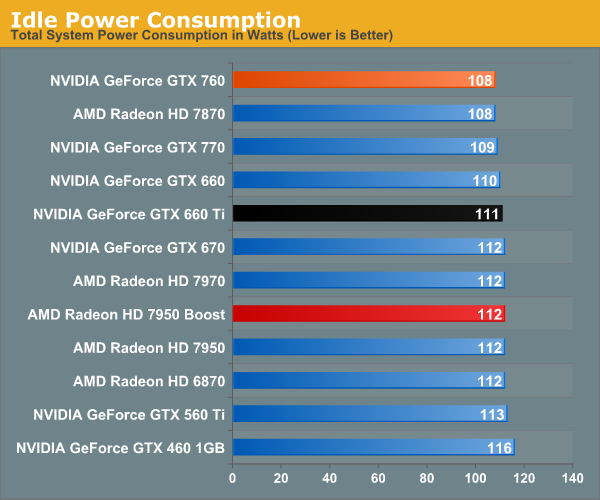
As we saw with the GTX 770 a few weeks ago, NVIDIA’s idle power consumption as measured at the wall has come down a couple of watts compared to the older GK104 cards. With a lower idle clockspeed compared to the GTX 660 Ti and its ilk, NVIDIA has been able to shave off that wattage without any more substaintial changes. However I continue to be surprised that we’re seeing any difference between the GTX 760 and the 7950B, as AMD is no slouch here either.
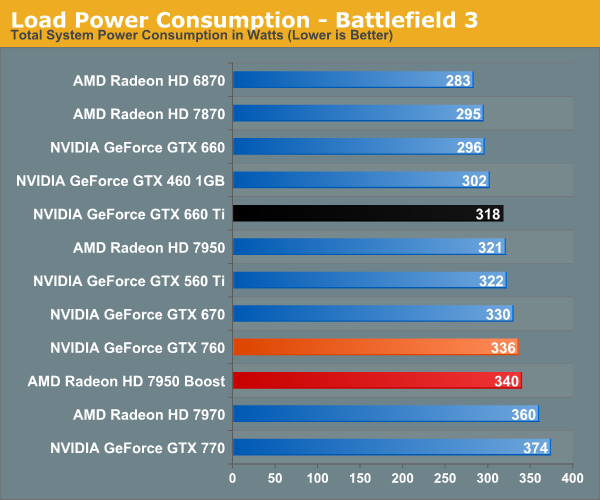
Moving on to load power under Battlefield 3, our results validate our earlier theories on power consumption based on the spec sheets. Wall power with a GTX 760 is 6W higher than GTX 670 in this test, and 18W higher than with a GTX 660 Ti. There’s no getting around the fact that GTX 670-like performance requires GTX 670-like power consumption.
At the same time the power consumption of the GTX 760 is almost identical to the 7950B at the wall. Though given the 7950B’s lower performance in this benchmark, what we’re actually seeing is lower CPU power consumption offsetting the 7950B’s higher power consumption.
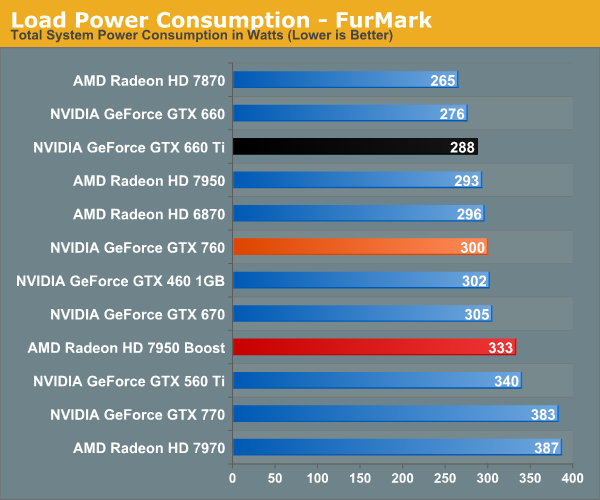
With Furmark the story is fairly similar for the NVIDIA cards, all of which come close together due to their similar TDPs. Meanwhile the 7950B pulls about 30W more at the wall, in-line with its 200W TDP. NVIDIA edged out AMD on power efficiency with the 600 series, and we’re going to see the same thing on the 700 series.
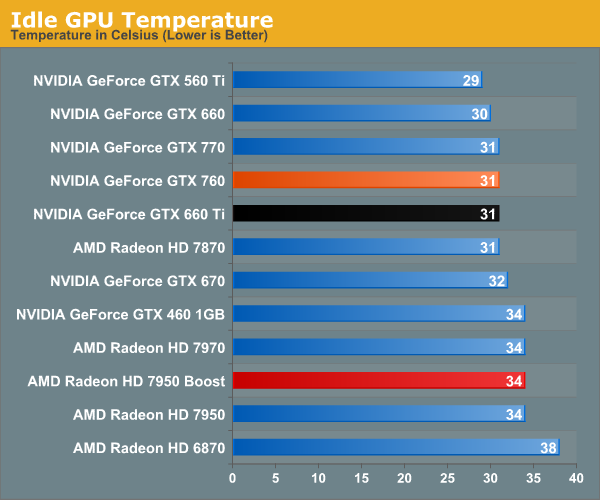
Based on the same cooler and GPU as the GTX 670, the GTX 760 offers no grand revelations here. 31C is standard for this type of blower cooler.
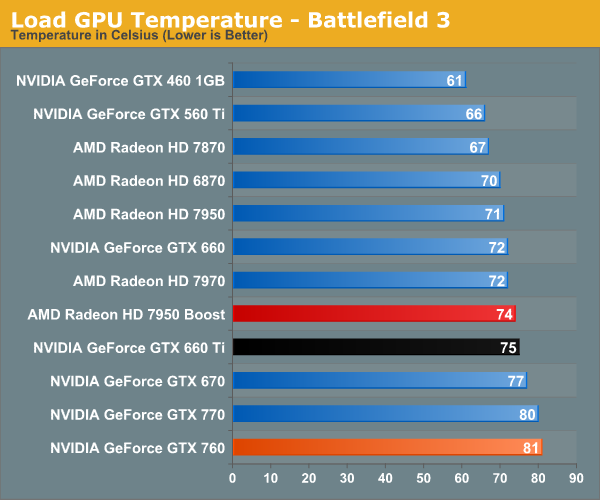
Even though the GTX 760 and GTX 670 have identical TDPs, the presence of GPU Boost 2.0 means that the GTX 760 operates nearer its TDP more often, and in this case the 80C throttle imposed by GPU Boost makes itself felt. 81C does end up being the worst among the cards in this collection, but it’s a reasonable temperature for a GK104 GPU, to the point where in temperature limited scenarios this is exactly where it’s designed to top out at.

With FurMark our results are much the same as with BF3. The slower response time of the fans on the GTX 770 and GTX 760 mean that both cards top out at 82C before temperatures level out, a few degrees warmer than with the GTX 670 and GTX 660 Ti. Alternatively the 7950B and its more powerful fan keep temperatures at or below 75C for any workload we throw at it.
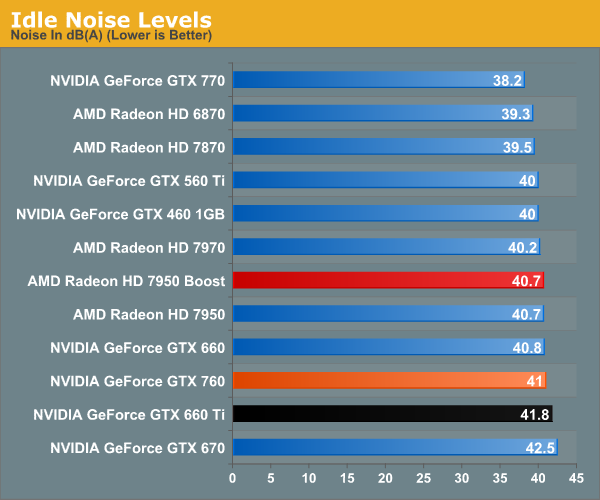
Since NVIDIA used the same cooler/fan assembly as on the GTX 670, the GTX 760 is going to give us similar acoustics. Unfortunately that includes the characteristic faint grinding noise that we’re previously mentioned. Idle noises as a result are respectable, but GTX 770 this is not.

Moving to fan noise under load, here we can see NVIDIA’s default fan curve and 80C throttle once again pay off. The GTX 760 hits 50dB under BF3, which for this specific cooler is actually doing a bit better than average, as evidenced by the slight advantage the GTX 760 has over the GTX 670. The GTX 770 and Fermi cards are something of spoilers here though, a reminder of what the Titan cooler and open air cooling can do. We will have some custom GTX 760s next week, so it will be interesting to see how much better these cards are when it comes to noise. 50dB is by no means bad, especially for the performance, but at this point we’ve seen lower noise levels out of cards with similar price tags and TDPs.
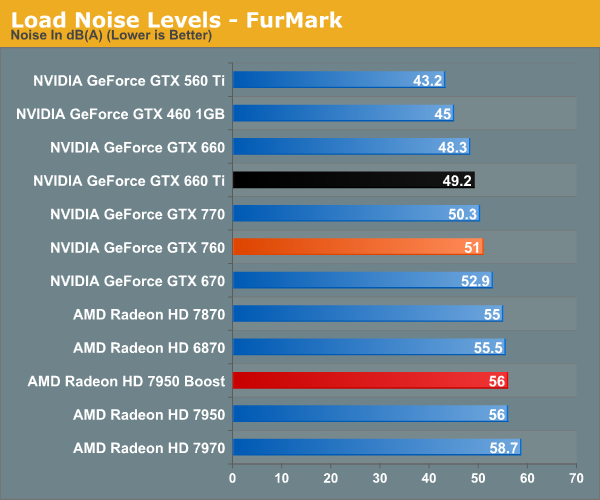
Finally, FurMark once again paints a picture very similar to what we saw with Battlefield 3. For NVIDIA cards this is middle of the road, while at 5dB quieter than the reference 7950B it’s a significant improvement.










110 Comments
View All Comments
Spunjji - Tuesday, June 25, 2013 - link
Why would a faster card need to be cheaper? Shoo, shoo! Back under your bridge.UltraTech79 - Tuesday, July 2, 2013 - link
???vailr - Tuesday, June 25, 2013 - link
Will there be a "Small Form Factor" version, similar to:http://www.newegg.com/Product/Product.aspx?Item=N8...
chizow - Tuesday, June 25, 2013 - link
Sad day in the GPU industry when a part that's ~75% of the *SECOND* tier ASIC and sells for $250 can be considered "Enthusiast".It looks like Nvidia's marketing push to carve out ultra and uber enthusiast markets has worked, on the media anyways. Parts in this range used to be referred to as mainstream/midrange performance or gamer cards in the past, never once referred to as "Enthusiast".
Honestly if this $250 part is "Enthusiast" what are the $400 770, the $650 780, the $1000 Titan??? I guess we need to cough up $250 more for each Uber we place in front of Enthusiast; maybe at some point we just find new words and categories when one has been devalued and depreciated to the point it no longer holds any meaning.
Aside from the rant, the part's price and performance looks good. It's pretty clear at this point Kepler benefits more right now from the ROPs and bandwidth than SP and TMU. May change with future shader intensive titles, but the 760 pretty much confirms the 660Ti (and virtually any 30%+ bandwidth-neutered parts) was a big mistake.
thesavvymage - Tuesday, June 25, 2013 - link
who cares what ASIC it comes from, its irrelevant. Its a $250 gpu that performs as well or better than more expensive cards. Thats not mainstream, its enthusiast. Everything above it is enthusiast. The absolutely biggest amount of gpu sales come from those south of $200, so thats what most people consider mainstream.chizow - Wednesday, June 26, 2013 - link
People who don't enjoy getting less for the same price care what ASIC it comes from. I guess you don't mind getting smaller and smaller burgers, or less and less ounces in the food you buy at the grocery each year?There is nothing enthusiast about this product, it's mainstream performance in the same price and market bracket that litters all of Nvidia's previous marketing slides in this $200-$300 range. Was the 8800GT an enthusiast card? No. Was the 560Ti an enthusiast card? No. Yet they both satisfy the criteria you set forth.
teiglin - Tuesday, June 25, 2013 - link
I was just thinking about this after reading the review over at Tom's (they refer to the 760 as mainstream). It's an interesting sociological exercise, how different people view the term enthusiast. Given the massive stratification at the high end--I mean, Titan, ffs--what is the cutoff for being an "enthusiast" card? Why even bother with hyperbolic modifiers when nobody who spends even $400 on a GPU would do so without knowing the difference between a 770, a 780, and a Titan, not to mention the 7970 [GHz edition], 7950 [Boost], etc.?Personally, I'm inclined to agree with Ryan here. This is still a heckuva lot more graphics horsepower than, say, certain yet-to-be-released consoles, which I would argue define a "mainstream" baseline. Though if you're just commenting on how much the lowest common denominator in graphics performance has fallen, then that may be a sad day for the GPU industry, but it's a good day for consumers, who are able to get way more GPU for much less money than a couple years ago.
chizow - Wednesday, June 26, 2013 - link
Sorry but getting "way more GPU for much less money than a couple years ago" is just progress and should be expected.The context for how different people view the term enthusiast should be consistent, based on historical price and performance categories as well as physical and marketing segmentation factors. All of which indicate this is NOT an enthusiast part. Nvidia has clearly defined this in the past, and the enthusiast market did not start until $350+.
Some may say, "who cares", I guess people who actually shop in this $350+ market care, because calling a $250 part sets a terrible precedent, same as selling a tier-2 midrange ASIC like GK104 at $500 sets a terrible precedent. Why? Because if Nvidia is selling their 2nd fastest ASIC at "Enthusiast" price ranges starting at $250 all the way to $500, that gives them license to sell their actual Enthusiast parts at much more than $500.
Is it any surprise that we now have $650 GTX 780 and $1000 GTX Titan and GTX 690? Of course not. Why? Because people are doing cartwheels in the streets over the privilege of buying a stripped down, overclocked 2nd-tier ASIC for $250, because it's the new enthusiast part!
UltraTech79 - Tuesday, July 2, 2013 - link
I put the $1000 Tital as 'Rich retard soon parts with his money.' Also, shut the fuck up elitest dumbfuck. Anyone willing to spend $200+ on a GPU is an enthusiast and is looking for more than just enough.chizow - Friday, July 5, 2013 - link
Yes just like the guy who rices up his Civic is now driving a "luxury sports car". Just another idiot that doesn't understand I'm actually advocating against elitest pricing and marketing brackets, move along if you don't understand the concepts and repercussions.